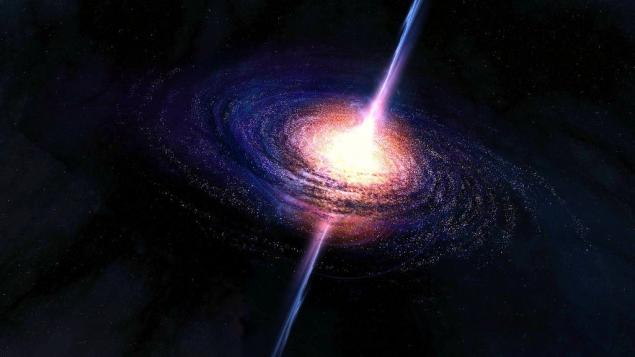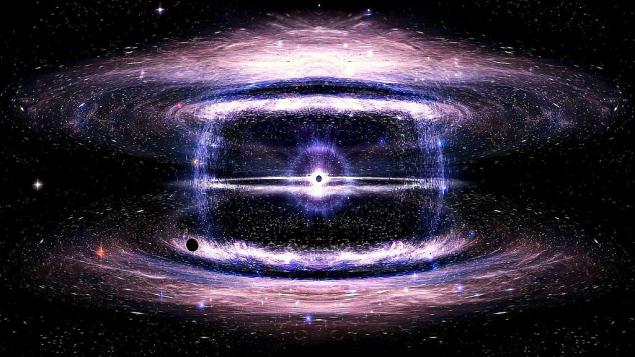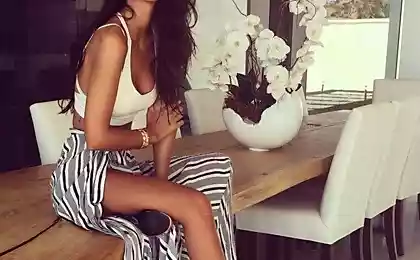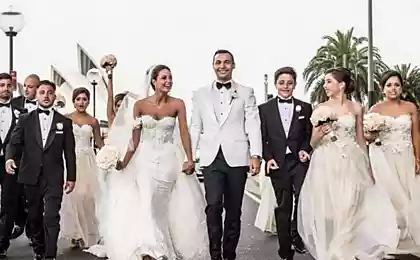1179
6 Surprising facts about black holes.

Black holes are perhaps one of the most amazing and frightening phenomena in our universe. They arise when the thermonuclear fuel in the huge mass of the stars is completely burned out, and the reaction stops. Stars begin to cool, which reduces the internal pressure and the compression of the body under the action of gravity, and then it begins to draw an object, and other objects smaller. Experts believe that black holes connected many of the most striking effects and phenomena, many of which we can not even imagine.

1. Black holes - the brightest objects in the sky
The force of gravity inside a black hole is so great that there can not escape, even light, therefore, the hole should be generally indiscernible in the sky. But do not forget that in addition to "event horizon", the border crossing after which the light to break back can not, there are still many around nepogloschёnnyh objects. When rotating black hole absorbs a cloud of interstellar gas, a substance close to it in a spiral, twisting, like water flowing down the drain. And then, these objects begin to glow.
Meteors light up the real, because a thin layer of gas is compressed by a sharp fall and incredibly rapid motion of cosmic solids and is further heated by friction. When the cloud of gas falling directly into the black hole, all the particles are compressed and are carried to its center, more and more heated due to friction. The particles become so hot that it is not just glow bright white light, they have emit X-rays, and 10% of their mass is converted into pure energy. For comparison, the explosion warhead only 0, 5% of its mass is converted into energy. Do you understand? Black hole - an area in contact in which even the smallest particles released 20 times more energy than a nuclear explosion.
Black holes can shine so brightly that win their own gravity. Supermassive black hole can reach the Eddington luminosity when the force of the continuous emission wins irresistible attraction. The radiation becomes so intense that there is a real stellar wind, due to which a part of the attractive material is repelled. Yes: the light can be so intense that even the eject themselves from the black hole.

2. Black holes spawned galactic explosions in our galaxy
Black holes provide the most powerful gravitational acceleration. In addition, they - the heaviest objects in the universe. Connect with one another - and get the powerful explosion. By the way, this is already happening, and not just anywhere, but in our galaxy.
Thanks to these two cosmic explosions in space has directed a tremendous amount of "bubbles", consisting of particles with high energy. The average size of the "bubble" - 25 000 light-years across. After passing through the middle of the galaxy, they have become more like a "flake", ie, purchased a flat shape. Now, these bubbles can be seen in most parts of the cosmos known to us and is likely to expand over the millions of years already.
Scientists believe it was caused by a cosmic doomsday collision with a dwarf galaxy to our Milky Way. At this point, its central black hole collided with our Sagittarius A and were partially offset by together, however, with the entire galaxy. However, before being finally "eaten" by local supergiant black hole could shoot in a spiral through our galaxy. Now scientists are looking for the consequences of this conflict - such as stars, pushed out with normal orbits, or any other traces of the incident.

3. In the universe there are millions of black holes
Above bright black holes also known as active galactic nuclei and quasars. They are not just bright objects - they can be a thousand times brighter than the rest of the galaxy together objects, because these objects are their potential "food". They are so bright that we used to mistake them for stars.
Little black hole mass can supply a nearby star, caught by the gravitational field of the hole, but still could not make out the smallest particles to be absorbed his final hole.
Glowing black holes are extremely useful when creating a map of the universe, because thanks to them in small areas of space focuses tremendous energy, and such energy emissions can create so-called spatial markers. Of course, to understand what is happening beyond the visible space in our telescopes, we can not, and until recently it was assumed that black holes - a rare phenomenon. Recently, however, it turned out that almost every galaxy in the center is a supermassive black hole. It turns out that to date, we know of 25 million black holes.

4. It is believed that black holes emit antimatter constantly
In 1974, Stephen Hawking described the hypothetical process of emission of a variety of elementary particles, especially photons black hole. The process is called "Hawking radiation».
The idea that the universe is constantly generates pairs of the form "particle-antiparticle." They derive their energy for the existence and immediately annihilate each other as a result of the explosion of gamma radiation which returns energy back. The whole process happens so fast that the Heisenberg uncertainty principle can not take it into account.
But if these virtual particle-antiparticle pairs appear on the edge of the event horizon, one of which is absorbed by the black hole, while the other can continue to exist freely. Hawking radiation implies that the event horizon is a 50/50 mixture of matter and antimatter, which will agree, adds some explosive beauty of the universe. The theory would sound like gibberish if it was not created by one of the smartest people on the planet: Stephen Hawking continues to work on the detection of these particles and the confirmation of his hypothesis.
5. We assume that black holes may explode
According to the law of conservation of energy for everything, sooner or later you have to pay, even if the "debtor" is a black hole, which must somehow compensate for the energy received from the outside. For large black holes is not a problem: Hawking radiation is too small compared to the amount of absorbed space matter. But it is a small black holes can emit more energy than they consume.
If the black hole consumes less material than emitting it ultimately could mean her death: in the end it just explodes. But do not worry - this black hole is too small to its explosion could cause serious damage to the galaxy.
6. Black holes emit death rays intergalactic
Everyone knows that black holes absorb any substance that enters into their gravitational field. However, few people know that they can more and emit beams of energy giant, like a shot from a space gun. This stream of energy is comparable to the size of the galaxy M 87 - one of the largest and closest galaxy to us. That is, a ray - the length of the plasma jet is 5000 light-years.
While the black hole consumes matter, she also shoots polarized proton beams at a speed near the speed of light. The reasons for the phenomenon are still under study, but we already know that the process is carried out using a rotary star electromagnetism and hydrodynamics, which contributes to "penetration" of holes in the fabric of space-time.
In the photo you see a guy galaxy 3C321, escapes from the plasma beam. In the bottom left the galaxy pink black hole at the center is located in such a way that the jet of it falls into the blue radio wave spectrum. This means that the cosmic gamma rays, X-rays and relativistic particles thrown at a distance of 20 000 light-years from the galaxy. Pink and blue bright spot - a place where the jet caused major damage to the galaxy, destroying on the way those planets and stars that might be there.
This black hole is called the "Death Star" because even if you're a scientist, used to treat stellar explosions as an ordinary event, when it happens in reality, not in a science fiction film, it is striking much more.
That everything in the universe - not one infinite space and infinite
Universe as an analogue of the human brain.
























